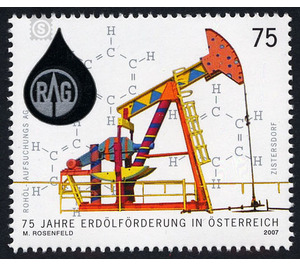75 years - Austria / II. Republic of Austria 2007 - 75 Euro Cent
Theme: Economy & Industry
| Country | Austria / II. Republic of Austria |
| Issue Date | 2007 |
| Face Value | 75.00 |
| Edition Issued | 1,200,000 |
| Printing Type | offset |
| Stamp Type | Commemorative |
| Item Type | Stamp |
| Chronological Issue Number | 2020 |
| Chronological Chapter | OOS-OE2 |
| SID | 843617 |
| In 55 Wishlists | |
Oil is the engine of our economy - we are aware of this on a daily basis when we realize that almost every political crisis immediately pushes up oil prices. In the interwar period important production sites were still in Europe, one of them in the Lower Austrian Weinviertel. At the time, the center of the excavation works was the Zistersdorf area, some 40 kilometers north of Vienna. In 1931, the then newly founded "Erdölproduktions-Gesellschaft m.b.H." (EPG) - which would later open up the Zistersdorf oil field - together with the "Raky Danubia union" to cancel their first hole "Gösting 1". In the "Steinbergflysch" gas was drilled in 733.6 meters depth and on November 9, 1932 at 785.5 meters made a screeding attempt, as a result of which the borehole got a self-effluent oil production. This was the birth of commercially exploitable oil production in Austria. To transport the oil, a pipeline of about 2.5 kilometers in length was moved from the borehole to the Zistersdorf railway station, where in a ceremony on February 16, 1933, the oil was transported to the Shell Mineral Oil Factory AG refinery in Vienna-Floridsdorf. Until today, crude oil and natural gas are mined in the Marchfeld and north of it. Countless derricks and pump stands still indicate the economic importance of the promotion. Petroleum - the "black gold" - is a so-called "lipophilic mixture of substances" stored in the earth's crust and consisting predominantly of hydrocarbons. Interestingly, Crude Oil, with its incredible 17,000 constituents, represents one of the most complex mixtures of organic matter occurring naturally on Earth! In modern industrial societies, oil is the most important raw material. Not only for the production of fuels, but also as a raw material for the chemical industry, it has outstanding economic importance. Color and consistency can vary from transparent and fluid to deep black and thick viscous. Its characteristic odor comes from the sulfur compounds - and it can switch between pleasant and disgusting repulsive. However the sensory impressions are perceived, it is clear that color, texture and smell are highly dependent on their geographical origin. By the way: on the new special stamp, Swiss Post has "captured" the typical smell of petroleum. By rubbing the displayed drop (top left in the brand image), you release the authentic aroma.


